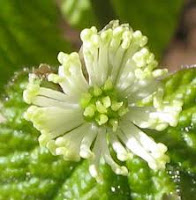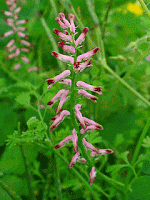 SOLOMON’S SEAL, POLYGONATUM ODORATUM, P. OFFICINALE
SOLOMON’S SEAL, POLYGONATUM ODORATUM, P. OFFICINALESolomon’s Seal is so called because of the marks or scars left on the rhizome when the stem has died back. Solomon’s seal was a ring given to the King who was reputed to be very wise by God or Allah. It symbolized human wisdom or super-wisdom as Solomon was thought to have and God’s grace.
The plant is related to the
lily-of-the-valley, and it certainly looks like a larger version of this, but it can have either white of creamy-yellow flowers. It is a member of the Liliaceae or lily family of plants so is related to the
Arum lily too.

It has been used in traditional medicine to help knit bones together when taken internally either in an infusion or a decoction, and the parts used are the rhizomes. The rest of the adult plant is poisonous, although the young shoots may be eaten in spring like
asparagus. The pounded fresh root has been used to reduce the discolouration of bruising as John Gerard, the 16
th century English herbalist points out.
“The roots of Solomon's Seal, stamped while it is fresh and greene and applied, taketh away in one night or two at the most, any bruise, blacke or blew spots gotten by fals or women's wilfulness in stumbling upin their hastie husband's fists, or such like.”
He goes on to add:
“As touching the knitting of bones and that truly which might be written, there is not another herb to be found comparable to it for the purposes aforesaid; and therefore in briefe, if it be for bruises inward, the roots must be stamped, some ale or wine put thereto and strained and given to drinke . . . as well unto themselves as to their cattle,' it being applied 'outwardly in the manner of a pultis' for external bruises.”
Nicholas Culpeper writing in the 17th century concurs with Gerard and adds some information of his own.

“
Government and virtues. Saturn owns the plant, for he loves his bones well. The root of Solomon's Seal is found by experience to be available in wounds, hurts, and outward sores, to heal and close up the lips of those that are green, and to dry up and restrain the flux of humours to those that are old. It is singularly good to stay vomitings and bleeding wheresoever, as also all fluxes in man or woman; also, to knit any joint, which by weakness uses to be often out of place, or will not stay in long when it is set; also to knit and join broken bones in any part of the body, the roots being bruised and applied to the places; yea, it hath been found by experience, and the decoction of the root in wine, or the bruised root put into wine or other drink, and after a night's infusion, strained forth hard and drank, hath helped both man and beast, whose bones hath been broken by any occasion, which is the most assured refuge of help to people of divers counties of the land that they can have. It is no less effectual to help ruptures and burstings, the decoction in wine, or the powder in broth or drink, being inwardly taken, and outwardly applied to the place. The same is also available for inward or outward bruises, falls or blows, both to dispel the congealed blood, and to take away both the pains and the black and blue marks that abide after the hurt. The same also, or the distilled water of the whole plant, used to the face, or other parts of the skin, cleanses it from morphew, freckles, spots, or marks whatsoever, leaving the place fresh, fair, and lovely; for which purpose it is much used by the Italian Dames.”

As a tisane it is used for stomach disorders and for menstrual cramps and other ‘female problems.’ It has been used in this way by Native Americans for centuries. In recommending this herb for pimples and freckles, these old herbalists were echoing Galen (circa AD 130-200), so this wisdom goes back to ancient times.
The roots should be dug up in autumn when the above parts of the plant are dying and the berries are ripe. (These are very poisonous.)
Clinical trials have been carried out, but very few, however some seem to show that the plant may be helpful in treating both diabetes and cancer, although the trials have only so far been conducted on animals in the lab.
Solomon’s seal is also known as Lady’s Seal and the old herbalists called it Sigillum Sanctae Mariae or Saint Mary’s Seal. There are several Latin names for different plants which all go under the general name of Solomon’s seal, Polygonatum multiflorum, P biflorum, P. giganteum, P.canaliculatum, P. commutatum are among these names. Polygonatum means many-angled and refers to the root system of the plant.

A tisane is made with one ounce of the chopped root to one pint of boiling water. Allow this to steep for 15 minutes and drink it for stomach cramps. It is also supposed to be good for the kidneys and was given for TB. The flowers and roots were used in love potions in the Middle Ages and Renaissance. This is not recommended these days, however, try dark
chocolate instead!

 Prior to the 17th century the whole plant was used in medicinal preparations, despite its being poisonous. It was used in decoctions to aid digestion and soothe the stomach to get rid of flatulence and was called Muscus terrestris or Muscus clavatum, meaning musk of the earth or musk claw. Lycopodium means wolf’s foot and clavatum, claw. The plant was harvested and dried for medicinal purposes, but it contains lycopodine which is poisonous and paralyses the motor nerves while the substance clavatine also present in the plant is toxic to many mammals; deer, for example do not eat club moss. The decoctions of the plant have been used to help get rid of calculus which builds up around the joints causing inflammation, so it was used for arthritis and rheumatism, as well as gout. It had a reputation for being good for the kidneys.
Prior to the 17th century the whole plant was used in medicinal preparations, despite its being poisonous. It was used in decoctions to aid digestion and soothe the stomach to get rid of flatulence and was called Muscus terrestris or Muscus clavatum, meaning musk of the earth or musk claw. Lycopodium means wolf’s foot and clavatum, claw. The plant was harvested and dried for medicinal purposes, but it contains lycopodine which is poisonous and paralyses the motor nerves while the substance clavatine also present in the plant is toxic to many mammals; deer, for example do not eat club moss. The decoctions of the plant have been used to help get rid of calculus which builds up around the joints causing inflammation, so it was used for arthritis and rheumatism, as well as gout. It had a reputation for being good for the kidneys. In the 17th century it was harvested and used only for its spores which are not poisonous, and these have been used as talcum powder, to stop things sticking together, as a dusting powder, to dress moulds in iron foundries and the stems of the plant when dried have been woven into matting. The spores are also used in fireworks and to produce the effect of artificial lightning.
In the 17th century it was harvested and used only for its spores which are not poisonous, and these have been used as talcum powder, to stop things sticking together, as a dusting powder, to dress moulds in iron foundries and the stems of the plant when dried have been woven into matting. The spores are also used in fireworks and to produce the effect of artificial lightning.  The spores are shaken from the kidney-shaped capsules (sporangia) which are found on the inner sides of the bracts which cover the fruit spike of club moss, and are a yellow powder. They have been used on injuries as they absorb fluids which exude from wounded tissue. They have diuretic qualities and can help in cases of chronic diarrhoea and dysentery. They would also appear to have some antispasmodic actions.
The spores are shaken from the kidney-shaped capsules (sporangia) which are found on the inner sides of the bracts which cover the fruit spike of club moss, and are a yellow powder. They have been used on injuries as they absorb fluids which exude from wounded tissue. They have diuretic qualities and can help in cases of chronic diarrhoea and dysentery. They would also appear to have some antispasmodic actions. This plant is a very common one, but tricky to harvest so best left to grow in the wild, unless you absolutely know what you are doing.
This plant is a very common one, but tricky to harvest so best left to grow in the wild, unless you absolutely know what you are doing.


















